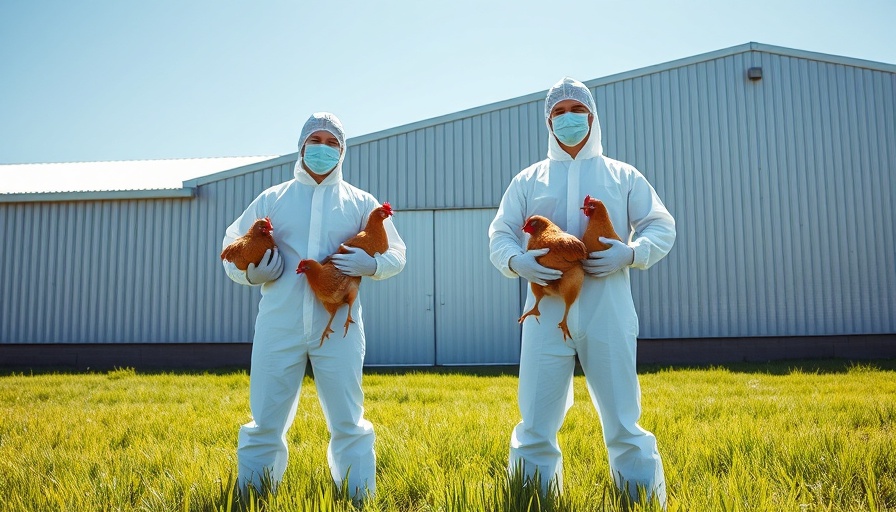
USDA Considers Vaccination for Chickens Amid Avian Flu Crisis
In a response to the ongoing challenges posed by highly pathogenic avian influenza, the United States Department of Agriculture (USDA) is contemplating a vaccination strategy for laying chickens. This initiative comes amid a nationwide disruption in egg supply, heightened by the recent avian flu outbreak that has persisted since 2022. With egg prices soaring—up 53% from January 2024 to January 2025, with expectations of a 40% increase in the coming year—the urgency to find sustainable solutions has never been greater.
Understanding the Bird Flu Outbreak
The outbreak has seen over 166 million poultry and 973 dairy herds affected across the country, and there have been tragic human implications as well, with 70 recorded cases among humans, including a fatality. This alarming situation has generated a multi-faceted USD 1 billion plan to stabilize both poultry health and egg prices.
Historically, the USDA's battle against bird flu has relied heavily on culling infected flocks. However, the extensive culling has notably contributed to the spike in egg prices, prompting the necessity for exploring alternative solutions, including vaccines.
A Comprehensive Approach: Vaccination and Biosecurity
In recent statements, USDA Secretary Brooke Rollins highlighted the plan’s comprehensive approach, which includes $500 million for enhancing biosecurity measures on farms and $400 million dedicated to providing financial assistance to farmers impacted by the outbreaks. The agricultural community is keenly aware that biosecurity alone is insufficient to eradicate avian influenza; vaccination must play a role.
Rollins specified that the USDA is invested in $100 million research to develop effective vaccines and treatment options for laying chickens. This research aims to create a targeted vaccination strategy to minimize the need for large-scale depopulation of flocks. Some countries, such as France, have already initiated vaccinations against bird flu, albeit with concerns about their impact on international trade.
Potential Trade Implications and Resistance to Vaccination
A major point of contention in the debate over vaccination is the potential negative impact on the US poultry export market. Some industry experts argue that vaccination could signify the virus becoming endemic, which might deter trade partners from importing US poultry products. Ashley Peterson from the National Chicken Council argues for the continuation of culling practices, stating a preference for eradication over coping with the virus through vaccination.
In contrast, experts like Carol Cardona, an avian health professor, suggest that a hybrid approach—combining vaccination with enhanced biosecurity protocols—might offer a more balanced and effective response to the ongoing crisis.
Looking Ahead: The Future of Poultry Health
The USDA has conditionally licensed a new vaccine from Zoetis based on its demonstrated safety and expected efficacy against avian flu. Despite the hesitations surrounding vaccination, experts like Gino Lorenzoni argue that even if vaccination doesn’t completely prevent disease, it can significantly reduce the viral load within populations, ultimately slowing the spread and safeguarding additional farms.
Success in this vaccination rollout is contingent on collaboration with producers to ensure minimal disruption to trade while prioritizing the health of both poultry stocks and public safety. The USDA emphasizes that it will work closely with international partners to address trade concerns while mitigating the effects of potential vaccination.
The Bigger Picture: A Sustainable Poultry Industry
With challenges looming over the poultry industry and consumer prices, it is imperative for stakeholders—from farmers to policymakers—to adapt swiftly and strategically. The USDA's focus on vaccination, biosecurity, and comprehensive support reflects a broader commitment to not only combating avian flu but also ensuring the resilience of the poultry supply chain for the future.
As the demand for stable egg prices increases amidst the fear of future outbreaks, the integration of innovative solutions like vaccination could represent a crucial turning point for the farming community and its consumers alike.
Concluding this crucial discourse, stakeholders are encouraged to engage actively with the USDA as it implements its new strategies—your input will be vital in shaping the future of poultry health in the US.
 Add Row
Add Row  Add
Add 


Write A Comment